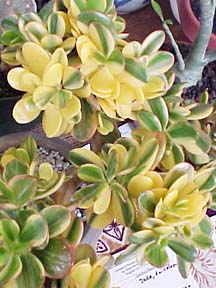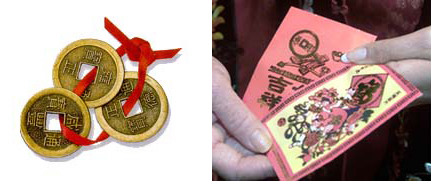
In the Garden![]()
Michael Miyashiro
Jade luck
The plant has long been
a symbol of prosperity
in Asian nationsCHINESE NEW YEAR
The Jade plant has long been a symbol of prosperity in Asian civilizations and is incorporated in today's feng shui designs. These easy-to-grow members of the succulent family thrive on neglect and poor conditions.
They make excellent gifts -- for the business, the start of new families and for money-conscious friends -- symbolizing prosperity and good luck.
The representation of jade plants and money are synonymous. The roundish leaves, said to mimic coins, represent money multiplying with each new set of leaves the plant produces.
RAINFOREST
During the Lunar or Chinese New Year, large pots of jade plants are often moved indoors and placed over stock and mutual fund certificates in hope that they will increase in value as the plants flourish and prosper. Red ribbons, "lai see" envelopes and Chinese coins are tied onto the plants' branches to further increase their value.
Other Chinese New Year plant options for the home include:
>> Kumquat branches laden with fruit: These can be tied with red ribbons or lai see paper and placed at the front door as you would a Japanese "kadomatsu," or pine and bamboo arrangement.
Everything you give comes back to you multiplied. A gift of orange fruits is symbolic of giving gold pieces to friends and family, and the sender gets back many happy returns. The Chinese word for oranges is "kum," which is the same word for gold.
>> Pineapples: Announce that good luck is coming. Place them in focal points in the home. Allow guests to see that good luck will be on its way.
>> Flowering branches of quince, forsythia, pussy willow: Announce that spring is on its way, thus increasing the odds that wealth and prosperity will follow. Fresh flowers kept indoors increase the flow of positive chi and bring in new chi from outside. This circulation of energy is the foundation of feng shui.
Flowers create calmness and relaxation, one of the key functions of feng shui. Remove all dead or dying flowers and plants from the home during the coming of the new year, which falls on Thursday (and throughout the year as well), and welcome the Chinese New Year with more lucky plant placements:
>> Red/orange (yang energy) flowers should be placed in areas of entertaining.
>> Yellow (yin energy) flowers coincide with health and healing. Place these in the kitchen, dining room or entrances.
>> Green (yin energy) signifies new beginnings, wealth and growth. Add to the kitchen, family room and parlor.
>> Orchids encourages strength and endurance. This plant/flower brings good chi into any room.
STAR-BULLETIN
Red ribbons and Chinese coins, left, and "lai see" envelopes are often tied to the branches of the Jade plant during Lunar New Year celebrations to bring prosperity and good luck to the owner.
THOSE WHOSE homes are full of good-luck bamboo might consider the jade plant, which, grounded in soil, is even more powerful than the bamboo, which loses its chi when new water is circulated it its pot and then flushed down the sink.
Jade plants kept indoors in the southeast corner of the home brings prosperity in its highest form.
If you are thinking of enhancing your home with a jade plant, this care sheet will help the beginner grow them successfully and help correct common myths and practices.
Talk of jade plants usually refers to two species: Crassula argentea/ovata and Portulacaria afra. Crassulas are generally considered to be true jade plants, while Portulacarias refer to the Ming jades.
There are many rare and unusual variations of these two species. They vary in leaf shape, size, growth habit, color and variegation. Some of the most prized forms sell for $100 up to $1,000, and others are family heirlooms, never to be sold on the open market.
Cultivation: When choosing jade plants for interiors, select plants with deeper green colorations over variegated forms. Look for plump multileafed plants with thick stems, and select plants that are in the size and form that you want them to be. Plants kept indoors usually don't grow as quickly or evenly as plants grown outdoors. Plants acclimated to interior living will be less subject to leaf drop once the transition is made. If a spot is selected near a sunny window, it will be wise to turn your pots daily so that all the leaves do not face the sun in a single direction.
Water your indoor plants wisely but thoroughly. Never allow your plants to sit in a dish of deep water. For most indoor-kept jade plants, water the pots until well saturated, and allow them to drip dry. Soaking very dry pots in shallow trays of tepid water for several minutes is also beneficial.
The best watering-determining factor applicable to all plants is the weight method. Simply lift your plants that are well watered and check their weight. Anything much lighter in weight than this is a dry plant. Water your plants early in the day to allow them to dry out by night. Never water any plants at night! Water to saturate all portions of the soil, and allow excess water to drain freely. It's not necessary to fertilize indoor plants much, but a very dilute amount is good every now and then.
Outdoor cultivation: Jades perform well when grown in their optimum conditions of bright, unobstructed sunlight, with ample growing room and appropriate watering. With all these conditions, plus cool night temperatures in the low to mid-60s, your plants will produce white flowers with pink blushes. Cool night temperatures are a must for initiating flower buds to set. But don't fret if your plant never blooms. Jade plants are grown for their foliage exclusively over flowers.
When transplanting jades, use a good potting soil mix with ample cinders or pumice. Pick pots that will support a well-grown plant's weight. Choose pots more wide than deep. Propagation is simple: Just take three to five inch-long cuttings, let dry several days in the shade, then insert into smaller pots of potting soil and pumice/cinders. Pinch the tips to encourage branching and to make a fuller plant.
Fertilize with a good even-ratio fertilizer. A timed-release type is good and easy. A single application may last up to six months.
Jade plants are almost pest-free. Ants may bring a small herd of sucking pests. Use an alcohol swab to remove any visible pests. Keep your soil evenly wet when watering to prevent ants from taking residence in the soil.
Should you have a breakout of sucking insect pests, you may need to resort to spraying with a systemic insecticide. Orthene wettable powder is good and relatively safe, with little odor. This insecticide spray may be added directly to the soil, and the plant will absorb it through its roots.
For bonsai growth forms, pinch tips hard and resist the urge to fertilize them, which will result in shrunken leaves and a thicker stem. Keep them stunted in small pots, but do water them!
Michael Miyashiro, flower connoisseur and graduate of the University of Hawaii horticulture program, owns Rainforest at Ward Warehouse. Contact him at 591-9999 or e-mail rainforesthawaii@aol.com. "In the Garden" is a Friday feature.
Gardening Calendar



